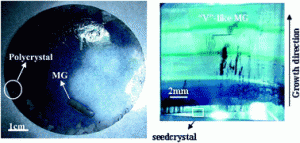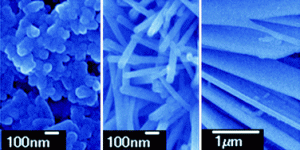Using nonlinear optical crystals for second harmonic generators is an exciting field, and in this CrystEngComm Hot article, a high quality single crystal of K3B6O10Br has been grown using a topseeded solution growth method. The crystal shows excellent second harmonic generation properties, three times better than KH2PO4
This work is particularly significant as this is the first time a single crystal of this type has been synthesised that is large enough to demonstrate NLO properties.
Find out more by reading the full paper…
Crystal growth and optical properties of a noncentrosymmetric haloid borate, K3B6O10Br
Min Zhang, Shi-Lie Pan, Xiao-Yun Fan, Zhong-Xiang Zhou, Kenneth R. Poeppelmeier and Yun Yang
CrystEngComm, 2011, Advance Article
DOI: 10.1039/C0CE00725K, Paper
FREE TO READ until 1st April











 Vanadium oxides with various connectivities of distorted VO6 polyhedra are characterized by tremendous structural diversity, which make them a seemingly huge playground for solid-state chemists.
Vanadium oxides with various connectivities of distorted VO6 polyhedra are characterized by tremendous structural diversity, which make them a seemingly huge playground for solid-state chemists.![Three-dimensional structure of [Cu3(trz)3(OH)3(H2O)4]](https://blogs.rsc.org/ce/files/2011/03/c0ce00919a-f8.gif)
 In this
In this 


 Designing coordination polymers with both lanthanide and transition metal centres is of great interest to the MOF community in terms of the often wierd and wonderful architectures that can be achieved as well as the properties that can be derived from these networks in such diverse areas as magnetism, luminescence, catalysis and molecular adsorption.
Designing coordination polymers with both lanthanide and transition metal centres is of great interest to the MOF community in terms of the often wierd and wonderful architectures that can be achieved as well as the properties that can be derived from these networks in such diverse areas as magnetism, luminescence, catalysis and molecular adsorption. In this CrystEngComm
In this CrystEngComm